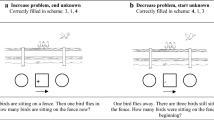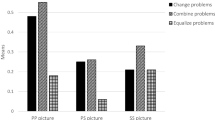Abstract
Three low-functioning children were successfully taught pictorial representations as communication means. Initially, the subjects were trained to associate cards representing objects with the corresponding objects. Then, they were trained to respond to: (a) cards depicting body positions, (b) cards depicting body positions related to objects, and (c) cards representing simple activities as well as activities involving two children. Subsequently, they were trained to complete cards representing activities involving two children, independently, and to choose the roles for the execution of these activities. At last, they were taught to select from among cards on display, to complete such cards, and to choose the roles for the execution of the activities all by themselves. During the program high generalization learning was observed.
Similar content being viewed by others
References
Arick, J. R., & Krug, D. A. Autistic children: A study of learning characteristics and programming needs.American Journal of Mental Deficiency, 1978,83, 200–202.
Barrera, R. D., Lobato-Barrera, D., & Sulzer-Azeroff, B. A. A simultaneous treatment comparison of three expressive language training programs with a mute autistic child.Journal of Autism and Developmental Disorders, 1980,10, 21–37.
Benaroya, S., Wesley, S., Ogilvie, H., Klein, L. S., & Meaney, M. Sign language and multisensory input training of children with communication and related developmental disorders.Journal of Autism and Childhood Schizophrenia, 1977,7, 23–31.
Bonvillian, J., & Nelson, K. Sign language acquisition in a mute autistic boy.Journal of Speech and Hearing Disorders, 1976,41, 339–347.
Bonvillian, J. D., Nelson, K. E., & Rhyne, J. M. Sign language and autism.Journal of Autism and Developmental Disorders, 1981,11, 125–137.
Bricker, D. D. Imitative sign training as a facilitator of word-object association with low-functioning children.American Journal of Mental Deficiency, 1972,76, 509–516.
Bricker, W. A., & Bricker, D. D. Development of receptive vocabulary in severely retarded children.American Journal of Mental Deficiency, 1970,74, 599–607.
Bricker, D. D., Ruder, K. F., & Vincent, L. An intervention strategy for language-deficient children. In N. G. Haring and R. L. Schiefelbusch (Eds.),Teaching special children. New York/McGraw-Hill, 1976.
Brookner, S. P., & Murphy, N. O. The use of a total communication approach with a nondeaf child: A case study.Language, Speech, and Hearing Services in Schools, 1975,6, 131–139.
Carr, E. G., Binkoff, J. A., Kologinski, E., & Eddy, M. Acquisition of sign language by autistic children. I: Expressive labeling.Journal of Applied Behavior Analysis, 1978,11, 489–501.
Deich, R. F., & Hodges, P. M. Teaching nonvocal communications to nonverbal retarded children.Behavior Modification, 1982,6, 200–228.
Fulwiler, R. L., & Fouts, R. S. Acquisition of American Sign Language by a non-communicating autistic boy.Journal of Autism and Childhood Schizophrenia, 1976,6, 43–51.
Guess, D., Sailor, W., & Baer, D. M.Functional speech and language training for the severely handicapped (Part 1). Lawrence, Kansas: H & H Enterprises, 1976 (a).
Guess, D., Sailor, W., & Baer, D. M.Functional speech and language training for the severely handicapped (Part 2). Lawrence, Kansas: H & H Enterprises, 1976 (b).
Guess, D., Sailor, W., & Baer, D. M.Functional speech and language training for the severely handicapped (Part 3). Lawrence, Kansas: H & H Enterprises, 1977.
Guess, D., Sailor, W., & Baer, D. M.Functional speech and language training for the severely handicapped (Part 4). Lawrence, Kansas: H & H Enterprises, 1978.
Guralnick, M. J. A language development program for severely handicapped children.Exceptional Children, 1972,39, 45–49.
Hartung, J. R. A review of procedures to increase verbal imitation skills and functional speech in autistic children.Journal of Speech and Hearing Disorders, 1970,35, 203–217.
Hewett, F. Teaching speech to an autistic child through operant conditioning.American Journal of Orthopsychiatry, 1965,35, 927–936.
Hingtgen, J. N., & Churchill, D. W. Identification of perceptual limitations in mute autistic children: Identification by the use of behavior modification.Archives of General Psychiatry, 1969,27, 68–71.
Horner, R. D., & Baer, D. M. A multiple-probe technique: A variation of the multiple base-line.Journal of Applied Behavior Analysis, 1978,11, 189–196.
Howlin, P. A. The effectiveness of operant language training with autistic children.Journal of Autism and Developmental Disorders, 1981,11, 89–105.
Jordan, T. E. Language and mental retardation. In R. L. Schiefelbusch, R. H. Copeland, and J. O. Smith (Eds.),Language and mental retardation: Empirical considerations. New York: Holt, Rinehart, and Winston, 1967.
Kahn, J. V. A comparison of manual and oral language training with mute retarded children.Mental Retardation, 1977,15, 21–23.
Kent, L. R.Language acquisition program for the severely retarded. Champaign, Illinois: Research Press, 1974.
Kiernan, C. A strategy for research on the use of nonvocal systems of communication.Journal of Autism and Developmental Disorders, 1981,11, 139–151.
Kohl, F. L., Wilcox, B. L., & Karlan, G. R. Effects of training conditions on the generalization of manual signs with moderately handicapped students.Education and Training of the Mentally Retarded, 1978,13, 327–334.
Konstantareas, M. M., Webster, C. D., & Oxman, J. Manual language acquisition and its influence on other areas of functioning in four autistic and autistic-like children.Journal of Child Psychology and Psychiatry, 1979,20, 337–350.
Kotkin, R. A., Simpson, S. B., & Desanto, D. The effect of sign language on picture naming in two retarded girls possessing normal hearing.Journal of Mental Deficiency Research, 1978,22, 19–25.
Linville, S. E. Signed English: A language teaching technique with totally nonverbal, severely mentally retarded adolescents.Language, Speech, and Hearing Services in Schools, 1977,8, 170–175.
Lovaas, O. I. A program for the establishment of speech in psychotic children. In J. K. Wing (Ed.),Early childhood autism: Clinical, educational and social aspects. London; Pergamon Press, 1966.
Lovaas, O. I.The autistic child: Language development through behavior modification. New York: Irvington, 1977.
Lovaas, O. I., Koegel, R. L., & Schreibman, L. Stimulus overselectivity in autism: A review of research.Psychological Bulletin, 1979,86, 1236–1254.
Lovaas, O. I., Koegel, R., Simmons, J. Q., & Long, J. S. Some generalization and follow-up measures on autistic children in behavior therapy.Journal of Applied Behavior Analysis, 1973,6, 131–166.
McDonald, E. T. Early identification and treatment of children at risk for speech development. In R. L. Schiefelbusch (Ed.),Nonspeech language and communication: Analysis and intervention. Baltimore: University Park Press, 1980.
McLean, L., & McLean, J. M. Language training program for non-verbal autistic children.Journal of Speech and Hearing Research, 1914,35, 186–193.
Murphy, G. H., Steele, K., Gilligan, T., Yeow, J., & Spare, D. Teaching a picture language to a non-speaking retarded boy.Behaviour Research and Therapy, 1977,15, 198–201.
Porter, P. B., & Schroeder, S. R. Generalization and maintenance of skills acquired in non-speech language initiation program training.Applied Research in Mental Retardation, 1980,1, 71–84.
Reich, G. Gestural facilitation of expressive language in moderately/severely retarded pre-schoolers,Mental Retardation, 1978,16, 113–117.
Reid, D. H., & Hurlbut, B. Teaching nonvocal communication skills to multihandicapped retarded adults.Journal of Applied Behavior Analysis, 1977,10, 591–603.
Richardson, R. Sign language for SMR and PMR.Mental Retardation, 1975,13, 17.
Risley, T. R., & Wolf, M. M. Establishing functional speech in echolalic children.Behaviour Research and Therapy, 1967,5, 73–88.
Robinson-Wilson, M. A. Picture recipe cards as an approach to teaching severely and profoundly retarded adults to cook.Education and Training of the Mentally Retarded, 1977,12, 69–72.
Rutter, M. Prognosis: Psychotic children in adolescence and early adult life. In J. K. Wing (Ed.),Early childhood autism: Clinical, educational and social aspects. London: Pergamon Press, 1966.
Salisbury, C., Wambold, C., & Walter, C. Manual communication for the severely handicapped: An assessment and instructional strategy.Education and Training of the Mentally Retarded, 1978,13, 393–397.
Salvin, A., Routh, D. K., Foster, R. E., & Lovejoy, K. M. Acquisition of modified American Sign Language by a mute autistic boy.Journal of Autism and Childhood Schizophrenia, 1977,7, 359–371.
Song, A. Acquisition and use of Bliss symbols by severely mentally retarded adolescents.Mental Retardation, 1979,17, 253–255.
Stremmel, K. Language training: A program for retarded children.Mental Retardation, 1972,10, 47–49.
Vanderheiden, D. H., Brown, W. P., MacKenzie, P., Reinen, S., & Scheibel, C. Symbol communication for the mentally handicapped.Mental Retardation, 1975,13, 34–37.
Webster, C. D., McPherson, H., Sloman, L., Evans, M. A., & Kuchar, E. Communicating with an autistic boy by gestures.Journal of Autism and Childhood Schizophrenia, 1973,3, 337–346.
Wehman, P., & Garrett, S. Language instruction with severely, profoundly, multihandicapped students: Two years of data.Mental Retardation, 1978,16, 410–412.
Wolf, J. M., & McAlonie, M. L. A multimodality language program for retarded preschoolers.Education and Training of the Mentally Retarded, 1977,12, 197–202.
Author information
Authors and Affiliations
Additional information
The execution of the present study was supported by funds from the Lega F. D'Oro Research Center (Italy).
Rights and permissions
About this article
Cite this article
Lancioni, G.E. Using pictorial representations as communication means with low-functioning children. J Autism Dev Disord 13, 87–105 (1983). https://doi.org/10.1007/BF01531362
Issue Date:
DOI: https://doi.org/10.1007/BF01531362




